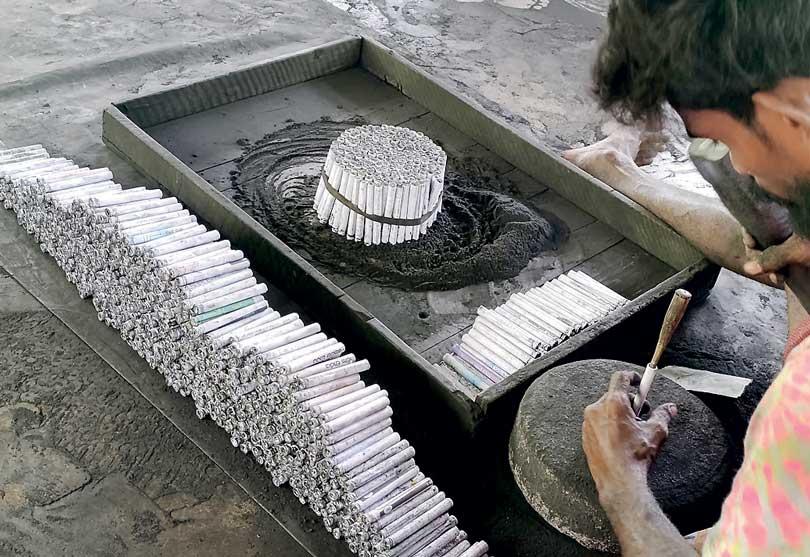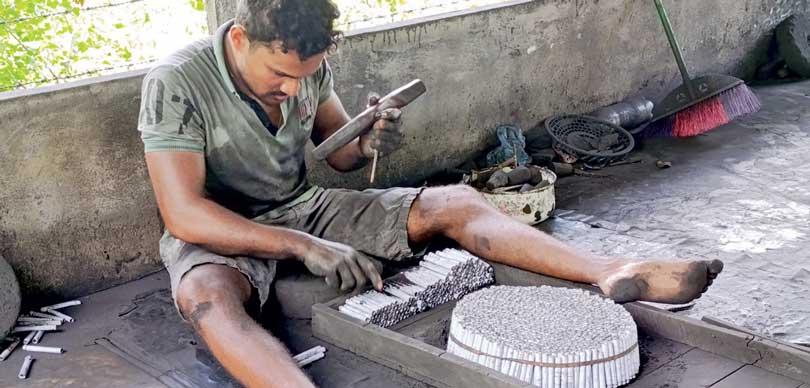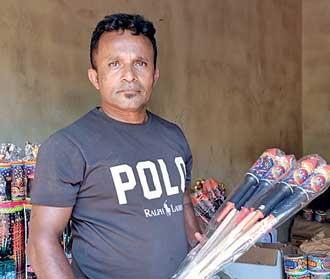Amidst Govt. restrictions….. Uncertainty looms over Kimbulapitiya’s creative fireworks industry

A youth is seen working in close proximity to gun powder and other chemical components, sometimes without adequate knowledge about occupational hazards

The art of manufacturing fireworks requires intense manual skills
“We have to obtain a permit to manufacture fireworks and we pay around Rs. 4000-4500 every year to renew the licence. But they have reduced the quota of chemical components we require. I used to get 300 bundles of perchlorate per year but now I get only 25 bundles”- Priyantha Henry Peters, Medium scale fireworks manufacturer (Kimbulapitiya)
Farmers are frequently purchasing skyrockets and firecrackers to chase away wild animals
The history of Kimbulapitiya crackers and fireworks spans over 90 years
Natural ingredients used to manufacture fireworks products during yesteryear have been replaced by chemical components
Media reports indicate many accidents that occur due to misfired fireworks

Priyantha posing for a photograph at his workshop |
Government’s restrictions on the issuance of chemical components to licensed firecracker manufacturers have kept small and medium scale manufacturers in the dark over the past few years. For Priyantha Henry Peters (53), a medium scale fireworks manufacturer from Kimbulapitiya, these restrictions have taken a toll on his business.
With an experience of over 25 years in the business, Priyantha had spent a greater part of his childhood in fireworks workshops. “Since Grade 6 (Six) I remember returning to the workshop after school and watching my seniors manufacture various fireworks products,” he recalled in an interview with the Daily Mirror. During the newspaper’s visit to Kimbulapitiya, the epicenter of the fireworks industry in Sri Lanka, popularly known as the ‘rathingna gammanaya’ (Sinhala term for fireworks village) this writer observed how almost every other household was busy manufacturing various kinds of fireworks ahead of the upcoming Avurudu (New Year) season.
According to seniors in the village, the history of Kimbulapitiya crackers and fireworks spans over 90 years. Some accounts suggest that the fireworks industry was introduced to Kimbulapitiya by Chinese traders back in 1940s, but Sri Lankans quickly learned the art of manufacturing firecrackers from Chinese traders, who went onto manufacture high quality products. But this scribe learned that the natural ingredients used to manufacture fireworks products during yesteryear have been replaced by chemical components such as perchlorate, potassium nitrate (saltpeter, a common oxidizer), aluminum type 969, magnesium and charcoal.
Reduction of accidents
Priyantha explained that with the introduction of perchlorate there was a reduction of accidents caused by fireworks. “Products made using perchlorate would ignite with the use of fire,” he said. But the burden of a shortage of chemical components have compelled small and medium scale manufacturers to depend on the black market where they would purchase these items at higher prices. However they claim that previous black market prices were not as expensive as today. Today, a kilo of perchlorate would cost anything between Rs. 85,000-100,000. “We need perchlorate to make firecrackers because we need the sound. We can use potassium nitrate as an alternative, but then the sound is less,” Priyantha explained.
According to the All Ceylon Fireworks Manufacturers Association, chemical components such as aluminum powder and potassium nitrate were not permitted for imports due to delays in the State Trading Corporation.
In Sri Lanka, the Explosives Ordinance No. 21 of 1956 regulates the use of commercial explosives. The Controller of Explosives is responsible for controlling and monitoring permits and licences for the use of commercial explosives in industries like quarry, firework, and match industries. “We have to obtain a permit to manufacture fireworks and we pay around Rs. 4000-4500 every year to renew the licence. But they have reduced the quota of chemical components we require. I used to get 300 bundles of perchlorate per year but now I get only 25 bundles. On the other hand I only get 75kg of saltpeter but this is not enough,” Priyantha added.
The permit requires manufacturers to possess a one acre property and they need to adhere to safety regulations in order to establish and operate a workshop. Many households in Kimbulapitiya include a workshop a few metres away from the house and trials are being done in abandoned lands in the vicinity. When asked about the safety of workers, Priyantha said that they depend on manually crafting various fireworks products as the use of machines cannot be guaranteed. Media reports indicate many accidents that occur due to misfired fireworks. Each year on average, around four to five individuals succumb to injuries following explosions. But a walk around Priyantha’s workshop gave us a hint of extra precautions being taken to ensure the safety of his staff. Two youth including his son were busy loading and stuffing skyrockets, which is a main product in his business. The fireworks industry doesn’t come with comfortable working environments. These skyrockets and other products would eventually end up in the hands of a customer who is waiting to celebrate the Avurudu season, but the hardships associated with the lives of these employees are often forgotten.
Interestingly, a post-season market too has developed over the years but during this time the price of a skyrocket, skyrockets to Rs. 7.50. “During the season I earn around Rs. 30-40 lakhs,” Priyantha continued. “I can’t expect profits post-season. It is barely sufficient for me to compensate my staff, pay the lease for my vehicle and look after my family,” he added. Priyantha further said that there is a market for cheena patas (local name for Chinese firecrackers) which is purchased to manufacture hakka patas (elephant crackers) used to chase away wild animals. But Priyantha doesn’t engage in the cheena patas business. The Daily Mirror learned that farmers are frequently purchasing skyrockets and firecrackers to chase away wild animals that cause crop damage.
Even though many youth are employed in the industry, they work without proper knowledge about occupational hazards. Often without a mask or necessary protective equipment, they work in close proximity to chemicals and gunpowder. Priyantha said that even though his son has shown an interest to continue the business, his two daughters may opt for better employment opportunities. Despite the fact that the fireworks industry continues to remain as a cottage industry, the majority of families in Kimbulapitiya and at least in four other grama niladhari divisions in Katana depend entirely on the fireworks industry. Priyantha said that the government should provide better facilities for people engaged in this industry. “A new law states that a manufacturer with a 40-perch land is entitled to obtain 40kg of aluminum. The quota of saltpeter is 75kg which is sufficient for three days. I recently purchased perchlorate at Rs. 90,000. So how can I expect profits,” he questioned.
The fact that the fireworks industry is an informal industry adds to the misery of fireworks manufacturers like Priyantha. “We are not demanding Samurdhi or any other relief from the government. Our only request to the government is to provide us with the designated quota of gun powder and chemical components required to meet our targets,” Priyantha said in conclusion.
After posing for a photograph, Priyantha returned to drying gunpowder sticks that were needed to complete a remaining stock of skyrockets. His wife was busy packing the products with colorful wrapping. Like his family, many other small and medium scale fireworks manufacturers work amidst looming uncertainties regarding the future of the fireworks industry.







 Kamanthi Wickramasinghe
Kamanthi Wickramasinghe